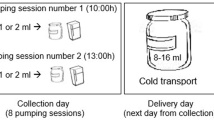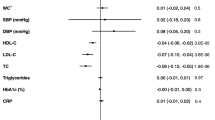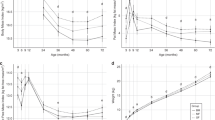Abstract
Background/Objective
Offspring’s optimal neurodevelopment depends on maternal dietary lipids supply during the perinatal period. Dairy products are an important source of fat in Western diets. This study aimed at examining the associations between maternal dairy fat intake during pregnancy, evaluated through biomarkers in perinatal biofluids (C15:0 and C17:0) and child’s cognitive outcomes.
Subjects/Methods
Participants (N up to 1200) were French mother-child pairs from the EDEN cohort study. Biomarkers were assessed in the following biofluids: maternal red blood cells (RBC) membrane at 24 weeks’ gestation, cord RBC membrane, and colostrum. Cognitive outcomes were language abilities scores at ages 2 and 3 years and overall cognitive development scores at ages 3 and 5–6 years. Associations were assessed using multiple linear regression models adjusted for factors related to family socioeconomic context, maternal lifestyle, and healthy diet score. Interaction of any breastfeeding duration on the associations with dairy fat biomarkers in colostrum was studied.
Results
Positive associations were observed between levels of C17:0 in cord RBC and C15:0 in maternal RBC with language abilities. In children breastfed for at least 6 months, C15:0 level in colostrum was positively associated with language abilities at age 3 years and overall cognitive development at ages 3 and 5–6 years whereas C17:0 level was only associated with overall cognitive development at age 3 years.
Conclusion
Our results suggest that maternal higher intake of dairy fat during perinatal period could be potentially associated with offspring’s better cognitive development. These pioneering results call for external validation to challenge their causality.
This is a preview of subscription content, access via your institution
Access options
Subscribe to this journal
Receive 12 print issues and online access
269,00 € per year
only 22,42 € per issue
Buy this article
- Purchase on SpringerLink
- Instant access to full article PDF
Prices may be subject to local taxes which are calculated during checkout



Similar content being viewed by others
Data availability
The data underlying the findings cannot be made freely available for ethical and legal restrictions imposed, because this study includes a substantial number of variables that, together, could be used to re-identify the participants based on a few key characteristics and then be used to have access to other personal data. Therefore, the French ethics authority strictly forbids making these data freely available. However, they can be obtained upon request from the EDEN principal investigator. Readers may contact [email protected] to request the data. The analytic code will be made available upon request pending application and approval.
Code availability
The data underlying the findings cannot be made freely available for ethical and legal restrictions imposed, because this study includes a substantial number of variables that, together, could be used to re-identify the participants based on a few key characteristics and then be used to have access to other personal data. Therefore, the French ethics authority strictly forbids making these data freely available. However, they can be obtained upon request from the EDEN principal investigator. Readers may contact [email protected] to request the data. The analytic code will be made available upon request pending application and approval.
References
Godfrey KM. Maternal regulation of fetal development and health in adult life. Eur J Obstet Gynecol Reprod Biol. 1998;78:141–50.
Prentice A. Micronutrients and the bone mineral content of the mother, fetus and newborn. J Nutr. 2003;133:1693S–9S.
Cifelli C, Hess J, Fulgoni VI. Contribution of Dairy Foods to Energy and Nutrient Intakes in Children and Adults: Analysis of Nhanes 2015–2018. Curr Dev Nutr. 2021;5:1021.
Anses. Avis de l'Anses relatif à “la troisième étude individuelle nationale des consommations alimentaires (Etude INCA3” (Saisine n°2014-SA-0234). 2014; https://www.anses.fr/fr/system/files/NUT2014SA0234Ra.pdf. Accessed 23 Feb, 2023.
Yuan WL, Bernard JY, Armand M, Sarte C, Charles MA, Heude B. Associations of maternal consumption of dairy products during pregnancy with perinatal fatty acids profile in the EDEN Cohort Study. Nutrients. 2022;14:1636.
Jonsson K, Barman M, Moberg S, Sjoberg A, Brekke HK, Hesselmar B, et al. Fat intake and breast milk fatty acid composition in farming and nonfarming women and allergy development in the offspring. Pediatr Res. 2016;79:114–23.
Park Y, McGuire MK, Behr R, McGuire MA, Evans MA, Shultz TD. High-fat dairy product consumption increases delta 9c,11t-18:2 (rumenic acid) and total lipid concentrations of human milk. Lipids. 1999;34:543–9.
Yahvah KM, Brooker SL, Williams JE, Settles M, McGuire MA, McGuire MK. Elevated dairy fat intake in lactating women alters milk lipid and fatty acids without detectible changes in expression of genes related to lipid uptake or synthesis. Nutr Res. 2015;35:221–8.
Bernard JY, Armand M, Garcia C, Forhan A, De Agostini M, Charles MA, et al. The association between linoleic acid levels in colostrum and child cognition at 2 and 3 y in the EDEN cohort. Pediatr Res. 2015;77:829–35.
Pranger IG, Joustra ML, Corpeleijn E, Muskiet FAJ, Kema IP, Oude Elferink S, et al. Fatty acids as biomarkers of total dairy and dairy fat intakes: a systematic review and meta-analysis. Nutr Rev. 2019;77:46–63.
Jensen RG. The composition of bovine milk lipids: January 1995 to December 2000. J Dairy Sci. 2002;85:295–350.
Li LJ, Du R, Ouidir M, Lu R, Chen Z, Weir NL, et al. Early pregnancy maternal plasma phospholipid saturated fatty acids and fetal growth: findings from a multi-racial/ethnic birth cohort in US. Nutrients. 2023;15:3287.
Heude B, Forhan A, Slama R, Douhaud L, Bedel S, Saurel-Cubizolles MJ, et al. Cohort Profile: the EDEN mother-child cohort on the prenatal and early postnatal determinants of child health and development. Int J Epidemiol. 2016;45:353–63.
Armand M, Bernard JY, Forhan A, Heude B, Charles MA. EDEN study group. Maternal nutritional determinants of colostrum fatty acids in the EDEN mother-child cohort. Clin Nutr. 2018;37:2127–36.
Kern S. Le compte-rendu parental au service de l'évalutation de la production lexicale des enfants français entre 16 et 30 mois [The parental report in service of assessing the lexical production of French children between 16 and 30 months (translated title)]. Glossa. 2003(85):48–62
De Agostini M, Metz-Lutz M-N, Van Hout A, Chavance M, Deloche G, Pavao-Martins I, et al. Batterie d'évaluation du langage oral de l’enfant aphasique (ELOLA): standardisation française (4-12 ans) [Oral Language Assessment Battery for Aphasic Children (ELOLA): French Standardization (4-12 years) (translated title)]. Rev Neuropsychol. 1998:319–67.
Peyre H, Galera C, van der Waerden J, Hoertel N, Bernard JY, Melchior M, et al. Relationship between early language skills and the development of inattention/hyperactivity symptoms during the preschool period: results of the EDEN mother-child cohort. BMC Psychiatry. 2016;16:380.
Korkman M, Kirk U, Kemp SL. NEPSY: bilan Neuropsychologique de l’enfant : manuel [NEPSY: Neuropsychological Assessment of the Child: Manual (translated title)]. ECPA - Editions du Centre de Psychologie Appliquée, Paris, 2003.
Kemp SL, Kirk U, Korkman M. Essentials of NEPSY Assessment. Marseille: Wiley; 2001.
Squires J, Potter L, Bricker D. The ASQ user’s guide for the Ages and Stages Questionnaires: a parent-completed child monitoring system. 2nd ed. Baltimore, Maryland: Brookes Publishing; 1999.
Wechsler D. Wechsler Preschool and Primary Scale of Intelligence (WPPSI-III). 3rd ed. Sant Antonio, Texas Psychological Corporation; 2002.
Fuhrer R, Rouillon F. La version française de l'échelle CES-D (Center for Epidemiologic Studies-Depression Scale). Description et traduction de l'échelle d’autoévaluation. Eur Psychiatr. 1989;4:163–6.
Deschamps V, de Lauzon-Guillain B, Lafay L, Borys JM, Charles MA, Romon M. Reproducibility and relative validity of a food-frequency questionnaire among French adults and adolescents. Eur J Clin Nutr. 2009;63:282–91.
Yuan WL, Nicklaus S, Lioret S, Lange C, Forhan A, Heude B, et al. Early factors related to carbohydrate and fat intake at 8 and 12 months: results from the EDEN mother-child cohort. Eur J Clin Nutr. 2017;71:219–26.
Caldwell BM, Bradley RH. Home observation for measurement of the environment. Little Rock, Arkansas;1984.
Tomova GD, Arnold KF, Gilthorpe MS, Tennant PWG. Adjustment for energy intake in nutritional research: a causal inference perspective. Am J Clin Nutr. 2022;115:189–98.
Bazinet RP, Laye S. Polyunsaturated fatty acids and their metabolites in brain function and disease. Nat Rev Neurosci. 2014;15:771–85.
Graham JW, Olchowski AE, Gilreath TD. How many imputations are really needed? Some practical clarifications of multiple imputation theory. Prev Sci. 2007;8:206–13.
Yuan WL, Bernard JY, Armand M, Peyre H, Charles MA, Heude B. Associations between heptadecanoic and pentadecanoic acids composition in maternal blood, cord blood and colostrum samples and child cognitive development. In: OSF. 2022. osf.io/3d6k2. Accessed 01 Jan 2022.
Pfeuffer M, Jaudszus A. Pentadecanoic and heptadecanoic acids: multifaceted odd-chain fatty acids. Adv Nutr. 2016;7:730–4.
Achon M, Ubeda N, Garcia-Gonzalez A, Partearroyo T, Varela-Moreiras G. Effects of milk and dairy product consumption on pregnancy and lactation outcomes: a systematic review. Adv Nutr. 2019;10:S74–S87.
Zheng L, Fleith M, Giuffrida F, O’Neill BV, Schneider N. Dietary polar lipids and cognitive development: a narrative review. Adv Nutr. 2019;10:1163–76.
Camfield DA, Owen L, Scholey AB, Pipingas A, Stough C. Dairy constituents and neurocognitive health in ageing. Br J Nutr. 2011;106:159–74.
Venn-Watson S, Lumpkin R, Dennis EA. Efficacy of dietary odd-chain saturated fatty acid pentadecanoic acid parallels broad associated health benefits in humans: could it be essential? Sci Rep. 2020;10:8161.
Wang WC, Ding M, Strohmaier S, Schernhammer E, Sun Q, Chavarro JE, et al. Maternal adherence to healthy lifestyle and risk of depressive symptoms in the offspring: mediation by offspring lifestyle. Psychol Med. 2023;53:6068–76.
Acknowledgements
We are extremely grateful to all the families who took part in this study, the midwives for their help in recruiting them, and the whole EDEN team, which includes psychologists, research scientists, engineers, technicians, and managers. The authors thank the EDEN mother-child cohort study group, whose members are I. Annesi-Maesano, JYB, J. Botton, MAC, P. Dargent-Molina, B. de Lauzon-Guillain, P. Ducimetière, M. de Agostini, B. Foliguet, A. Forhan, X. Fritel, A. Germa, V. Goua, R. Hankard, B. Heude, M. Kaminski, B. Larroque, N. Lelong, J. Lepeule, G. Magnin, L. Marchand, C. Nabet, F. Pierre, R. Slama, M.J. Saurel-Cubizolles, M. Schweitzer, O. Thiebaugeorges.
Funding
This study was sponsored by French Dairy Interbranch Organisation (CNIEL). The EDEN cohort study was financed by the Foundation for Medical Research (FRM), National Agency for Research (ANR), National Institute for Research in Public Health (IRESP: TGIR cohorte santé 2008 program), French Ministry of Health (DGS), French Ministry of Research, Inserm Bone and Joint Diseases National Research (PRO-A) and Human Nutrition National Research Programs, Paris–Sud University, Nestlé, French National Institute for Population Health Surveillance (InVS), French National Institute for Health Education (INPES), the European Union FP7 programs (FP7/2007-2013, HELIX, ESCAPE, ENRIECO, Medall projects), Diabetes National Research Program (through a collaboration with the French Association of Diabetic Patients (AFD)), French Agency for Environmental Health Safety (now ANSES), Mutuelle Générale de l’Education Nationale (MGEN), French National Agency for Food Safety, and the French-speaking association for the study of diabetes and metabolism (ALFEDIAM). Biological analyses of colostrum samples were funded by the PremUp foundation (French foundation for scientific cooperation in connection with pregnancy and prematurity) and the Groupe Lipides Nutrition (GLN). Biological analyses of red blood cell membrane were funded by the Institut Danone France and FRM (Prix IDF/FRM pour les Sciences de l’Alimentation 2015). All funders (except CNIEL with aforementioned involvement) had no influence of any kind on the study hypothesis/design, execution, analysis or interpretation.
Author information
Authors and Affiliations
Contributions
The authors’ responsibilities were as follows—WLY, JYB, and BH designed research. WLY conducted research. MA and CS provided essential materials. WLY performed statistical analysis. WLY wrote the initial draft. JYB, MA, CS, MAC, BH, and HP critically reviewed and edited the draft. WLY had primary responsibility for final content. All authors read and approved the final manuscript.
Corresponding author
Ethics declarations
Competing interests
Research support, including salaries, equipment, reimbursement for attending symposia, and maintenance of the EDEN cohort study, was provided by CNIEL. While CNIEL contributed to the study hypothesis, they were not involved in the study’s design, execution, or analysis. Academic independence was maintained throughout all stages of the study, as the study protocol was pre-registered on OSF prior to the study’s commencement and has remained unmodified to date [29]. Full academic independence for reporting and publishing all findings was mutually agreed upon and documented at the onset of the collaboration. Details regarding data sharing and access are provided in the “Data and Code Availability Statement” section of this manuscript.
Ethical approval
The EDEN mother-child cohort study was approved by the ethics committee of Kremlin Bicêtre (CPP reference 02–70, December 2002; CCTIRS reference 02-189, July 2002) and the National Data Protection Authority (“Commission Nationale de l’Informatique et des Libertés”, CNIL reference 902267, December 2002).
Additional information
Publisher’s note Springer Nature remains neutral with regard to jurisdictional claims in published maps and institutional affiliations.
Supplementary information
Rights and permissions
Springer Nature or its licensor (e.g. a society or other partner) holds exclusive rights to this article under a publishing agreement with the author(s) or other rightsholder(s); author self-archiving of the accepted manuscript version of this article is solely governed by the terms of such publishing agreement and applicable law.
About this article
Cite this article
Yuan, W.L., Armand, M., Peyre, H. et al. Associations between perinatal biomarkers of maternal dairy fat intake and child cognitive development: results from the EDEN mother-child cohort. Eur J Clin Nutr 79, 320–328 (2025). https://doi.org/10.1038/s41430-024-01544-3
Received:
Revised:
Accepted:
Published:
Issue Date:
DOI: https://doi.org/10.1038/s41430-024-01544-3



